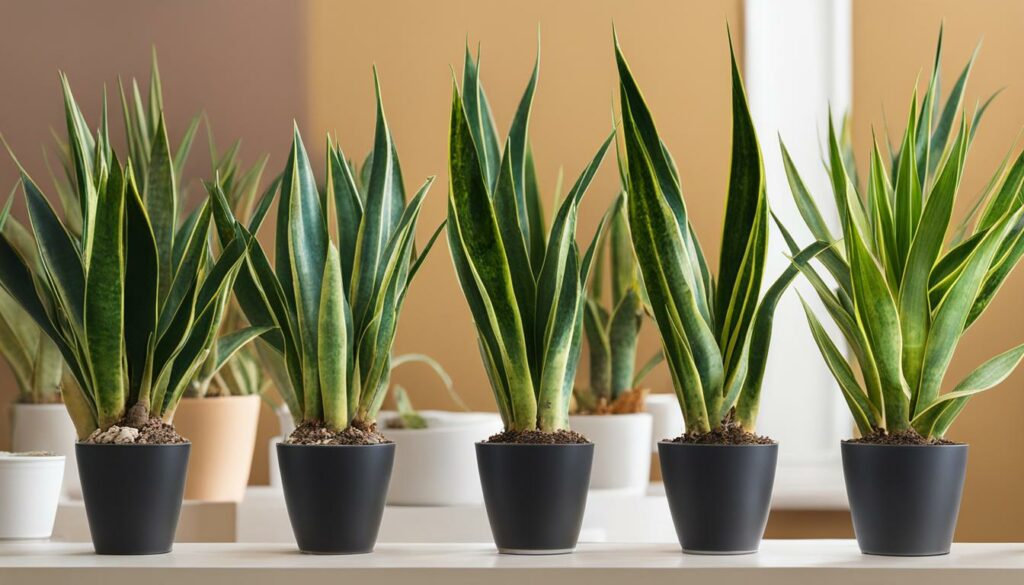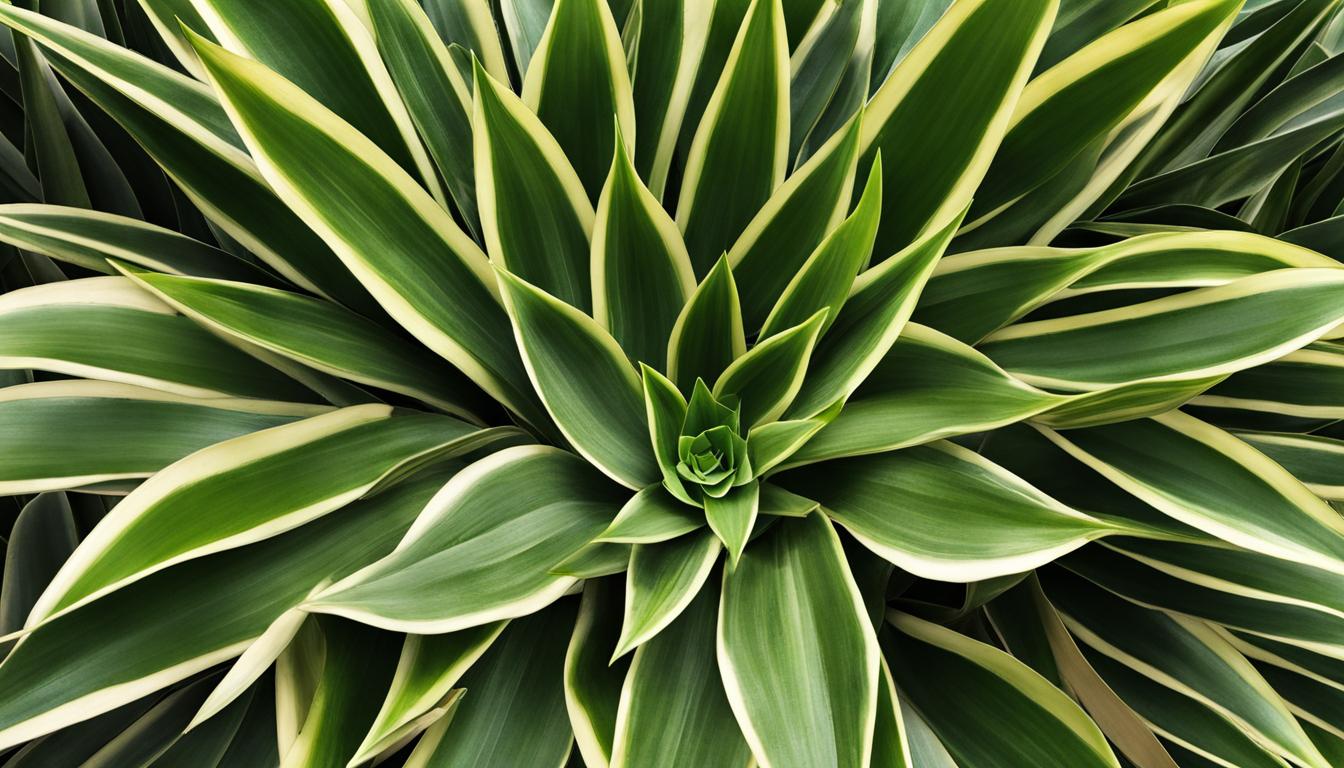Welcome to our comprehensive guide on propagating snake plants. If you’re a plant enthusiast looking to expand your collection or a beginner wanting to try your hand at plant propagation, you’ve come to the right place! In this article, we will walk you through the process of propagating snake plants, also known as Sansevieria trifasciata or Dracaena trifasciata. Whether you’re interested in water propagation, soil propagation, division, or rhizome propagation, we’ve got you covered with helpful tips and techniques. Let’s dive in and learn how to propagate snake plants successfully!
Water Propagation: A Simple DIY Method
Water propagation is a popular and simple method for propagating snake plants. To propagate using water, you’ll need to snip off a healthy leaf from the mother plant. Make sure to use a clean and sharp pair of scissors to avoid damaging the leaf. Once you have the leaf cutting, place the cut end in a container of water.
It’s important to use filtered or distilled water to prevent any chemicals or impurities from hindering the root growth. Position the container in a location with indirect sunlight to provide the necessary warmth and light for the cutting to root. Keep in mind that direct sunlight can be too intense and may scorch the leaf.
Over time, you’ll start to see roots forming from the cut end of the leaf. This process can take several weeks or even months, so be patient. Once the roots have grown to a decent length, you can transfer the cutting to a well-draining potting mix. Use a pot that is slightly larger than the root ball to allow for growth. Water the soil lightly and place the pot in a spot with bright, indirect sunlight.
| Water Propagation Steps: |
|---|
| Cut a healthy leaf from the mother plant. |
| Place the cut end in a container of filtered or distilled water. |
| Position the container in a spot with indirect sunlight. |
| Wait for roots to form, which can take several weeks or months. |
| Transfer the cutting to a well-draining potting mix. |
| Water lightly and place in a bright, indirect sunlight location. |
Why Choose Water Propagation?
Water propagation has several advantages that make it a popular choice among snake plant enthusiasts. It’s a great method for beginners because it’s relatively easy and requires minimal supplies. You don’t need to worry about finding the right potting mix or maintaining proper soil moisture levels.
Additionally, water propagation allows you to observe the root development more clearly. You can visually see the roots growing and monitor their progress. This method also gives you the opportunity to enjoy the unique aesthetic of the roots submerged in water.
Water propagation is a fascinating process that allows you to witness the growth of new roots from a single leaf cutting. It’s a wonderful way to propagate snake plants and expand your collection with minimal effort.
Overall, water propagation is a simple and rewarding method for propagating snake plants. It’s a great way to create new plants from existing ones and can be a fun and educational experience. Whether you’re a seasoned plant enthusiast or just starting your journey with snake plants, give water propagation a try and watch as the roots take hold and a new plant begins to grow.
Soil Propagation: Cuttings in Well-Draining Potting Soil
Soil propagation is another popular method for propagating snake plants. It involves taking cuttings and planting them in well-draining potting soil. This method allows you to mix different varieties of snake plants in one pot, creating a beautiful display of different shapes and colors.
To propagate snake plants in soil, start by cutting a single leaf near the soil line. Then, snip the leaf into several smaller pieces, making sure each cutting has a portion of the leaf and a small section of stem. Let the cuttings callus for a day or two, as this will help prevent rotting.
Once the cuttings have calloused, plant them in well-draining potting soil, burying them about an inch deep. Place the pot in a bright location with indirect sunlight and water sparingly, allowing the soil to dry out between waterings. Over time, the cuttings will develop roots and start to grow into new snake plant individuals.
It’s important to note that new plants grown from cuttings in soil may not have the same variegation as the parent plant. Additionally, because the roots are not visible, it can be difficult to determine if the cuttings have successfully rooted. However, with proper care and patience, soil propagation can be a successful method for propagating snake plants.
Plant Propagation by Division: Faster and Retains Variegation
Plant propagation by division is a popular method for propagating snake plants due to its speed and the ability to retain the variegation of the original plant. This technique involves dividing the root clump of a parent plant into multiple sections, each with at least three rhizomes. These sections are then planted in well-draining pots, allowing each section to grow into a new snake plant.
This method is particularly suitable for large snake plants that have multiple growths. By dividing the root clump, you can create several new plants from a single parent plant, which is cost-effective and allows you to expand your snake plant collection more quickly. Additionally, division ensures that the new leaves retain the same variegation patterns as the original plant, maintaining the unique aesthetic appeal.
When propagating snake plants by division, it is essential to choose a healthy parent plant with well-established rhizomes. Lay the parent plant down and carefully divide the root clump into sections, making sure each section has enough rhizomes to support new growth. Plant each section in well-draining pots filled with a suitable potting mix, and provide proper care to encourage healthy root development and overall growth.
| Table: Pros and Cons of Snake Plant Propagation by Division | |
|---|---|
| Pros | Cons |
| Fast method for propagating snake plants | Requires a large parent plant with multiple growths |
| New plants retain variegation patterns of the original plant | Can be challenging to divide the root clump without damaging the plant |
| Cost-effective way to expand your snake plant collection | Less suitable for propagating smaller snake plants |
Additional Tips for Successful Snake Plant Propagation by Division
- Choose a well-established parent plant with multiple growths to ensure a successful division.
- Use sharp, sterile tools to minimize the risk of damaging the parent plant during the division process.
- Ensure each divided section has at least three rhizomes to support healthy growth.
- Plant the divided sections in well-draining pots filled with a suitable potting mix.
- Provide appropriate care, including regular watering and indirect sunlight, to promote root development and overall plant growth.
Propagating snake plants by division offers a faster and more reliable method for expanding your snake plant collection. By carefully dividing the root clump and planting each section in well-draining pots, you can create multiple new snake plants that retain the variegation patterns of the original plant. Keep in mind the pros and cons of this method, and follow the tips mentioned above for successful propagation. Happy gardening!

Rhizome Propagation: Fast and Suitable for Variegated Snake Plants
Rhizome propagation is a fast and effective method for propagating snake plants, especially variegated varieties. This method does not require dividing the parent plant, making it a convenient choice for those who want to expand their snake plant collection without disturbing the original plant.
To propagate using rhizomes, follow these steps:
- Locate the rhizomes under the soil. Rhizomes are thick, horizontal stems that grow beneath the surface of the soil. They usually have a fleshy texture and can be easily identified.
- Cut the rhizomes off from the base of the plant. Use a sharp and clean knife or pruning shears to make clean cuts. Make sure each rhizome has at least one healthy bud or shoot.
- Allow the rhizomes to callus. Place the cut rhizomes in a warm and dry location for a few days to allow the cut ends to dry out and form a protective callus layer. This helps prevent rotting and promotes healthy root growth.
- Repot the rhizomes in potting mix. Choose a well-draining potting mix suitable for snake plants and plant the rhizomes in separate pots or together in a larger container. Ensure that the rhizomes are partially buried in the soil, with the bud or shoot facing upwards.
- Provide proper care. Place the newly potted rhizomes in a location with bright, indirect sunlight. Water the plants sparingly, allowing the soil to dry out between waterings. Overwatering can lead to rotting.
With proper care and a little patience, the rhizomes will develop roots and new shoots, giving rise to healthy and thriving snake plant offspring.
Benefits of Rhizome Propagation
Rhizome propagation offers several advantages over other propagation methods:
- Fast results: Rhizomes have already stored energy, allowing them to establish roots and grow new shoots quickly.
- Suitable for variegated snake plants: Rhizome propagation preserves the unique variegation patterns of variegated snake plants.
- No need to divide the parent plant: Unlike division propagation, which requires uprooting and dividing the parent plant, rhizome propagation can be done without disturbing the original plant.
Overall, rhizome propagation is a reliable method for expanding your snake plant collection and ensuring the successful growth of variegated varieties.
| Advantages | Rhizome Propagation | Division Propagation | Water Propagation | Soil Propagation |
|---|---|---|---|---|
| Fast results | ✔ | ✔ | ✘ | ✘ |
| Suitable for variegated snake plants | ✔ | ✔ | ✔ | ✘ |
| No need to divide the parent plant | ✔ | ✘ | ✔ | ✔ |

Tips for Successful Snake Plant Propagation
If you’re looking to propagate your snake plants successfully, here are some tips to help you along the way:
Use Healthy Leaves
When selecting leaves for propagation, make sure they are healthy and free from any signs of disease or damage. Healthy leaves will have a vibrant green color and firm texture, indicating that they have enough nutrients to support new growth.
Make V-Shaped Notches
Before placing your snake plant cuttings in water or soil, make v-shaped notches at the bottom of the cuttings. This will create more surface area for the roots to develop and increase the chances of successful propagation.
Prefer Leaf Top Cuttings
When taking cuttings, it’s best to choose the top growth of the plant. These cuttings have a higher chance of rooting successfully compared to cuttings taken from the lower parts of the plant.
Propagate Variegated Snake Plants through Division
If you have variegated snake plants, it’s recommended to propagate them through division rather than cuttings. This ensures that the new plants retain the variegation of the parent plant, giving you more beautiful and unique snake plants for your collection.
Be Patient
Snake plant cuttings take time to root and establish themselves. Be patient and provide the necessary care, including regular watering, indirect sunlight, and appropriate temperatures. It may take several weeks or even months for roots to develop, so don’t give up too soon.
Consider Using Rooting Hormone
If you want to speed up the propagation process, you can consider using rooting hormone. Rooting hormone contains growth-promoting substances that encourage root development, increasing the chances of successful propagation. Follow the instructions on the rooting hormone packaging for the best results.
By following these tips, you’ll increase your chances of successfully propagating your snake plants. Remember to provide them with the right conditions, monitor their progress, and be patient. Happy propagating!
Troubleshooting Snake Plant Propagation
If you’re experiencing difficulties with propagating your snake plant, don’t worry! Here are some common problems and their solutions to help you successfully grow new plants.
Problem: Snake Plant Cutting Not Growing Roots
If your snake plant cuttings are taking longer than expected to grow roots, don’t panic. Snake plant cuttings can sometimes be slow to root, so patience is key. It’s important to provide the right conditions for rooting, including indirect sunlight, proper humidity, and regular watering. Keep the cuttings in a warm location, around 70°F (21°C), and mist them occasionally to maintain moisture levels. Avoid overwatering, as it can lead to rotting.
Problem: Soggy and Brown Cuttings in Snake Plant Propagation
If your snake plant cuttings become soggy and brown, it’s a sign of rotting. This can happen if the cut ends of the leaf were not allowed to callous before planting or if the cuttings are being overwatered. To salvage the situation, you can try cutting off the affected parts to prevent further rotting. Make sure the cuttings have calloused properly before replanting them in well-draining soil. Adjust your watering routine to prevent excess moisture and ensure proper airflow around the cuttings.
Remember, successful snake plant propagation requires patience and proper care. By troubleshooting these common problems, you can increase your chances of growing healthy new plants from cuttings. Don’t get discouraged if you encounter setbacks along the way; learning from these experiences will make you a better plant propagator. Happy growing!
Conclusion
Propagating snake plants can be a rewarding and cost-effective way to expand your collection of these beautiful houseplants. By following the proper techniques and tips for snake plant care and propagation, you can successfully grow new plants from cuttings or division.
Remember to be patient as snake plant cuttings take time to root and establish themselves. Provide the necessary care, such as indirect sunlight, well-draining soil, and occasional watering. These low-maintenance plants are perfect for growing in indoor jungles, adding a touch of greenery to any space.
Whether you choose water propagation, soil propagation, division, or rhizome propagation, each method has its own advantages and considerations. Consider your preferences and the resources available to you when deciding which method to use. Experiment with the different techniques to find what works best for you.
So go ahead and give snake plant propagation a try! With a little patience, care, and love, you can watch your collection of snake plants grow and thrive. Enjoy the journey of growing these stunning plants and creating a lush, green oasis in your home.
FAQ
What are the different methods of propagating snake plants?
Snake plants can be propagated through water propagation, soil propagation, propagation by division, and rhizome propagation.
How do I propagate a snake plant using water?
To propagate using water, snip off a leaf from the mother plant, place the cutting in water, and provide indirect sunlight until roots develop.
Can water propagation retain variegation in snake plant cuttings?
Water propagation may not retain variegation in cuttings from variegated snake plant varieties.
What is the process of propagating snake plants in soil?
To propagate in soil, cut a single leaf near the soil line, let the cuttings callus, and plant them in well-draining potting soil.
Does soil propagation result in new plants with variegation?
New plants propagated in soil may not have variegation and root growth is not visible.
How can I propagate snake plants through division?
Lay the parent plant down, divide the root clump into sections, and plant them in well-draining pots to propagate through division.
Is rhizome propagation a fast method for propagating snake plants?
Yes, rhizome propagation is a fast method that involves cutting off and repotting rhizomes from the base of the plant.
How can I increase my chances of successful snake plant propagation?
Use healthy leaves, make v-shaped notches on the bottom of the cuttings, prefer leaf top cuttings, and consider using rooting hormone.
What should I do if my snake plant cuttings are not growing roots?
Give them more time as snake plant cuttings can take a while to root.
What should I do if my snake plant cuttings become soggy and brown?
Cut off the rotten parts and start over, as this indicates rotting due to not allowing the cut ends to callous or overwatering.



